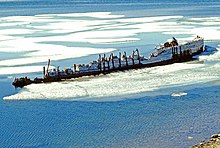Maud (ship)
|
||||||||||||||
|
||||||||||||||
|
||||||||||||||
|
||||||||||||||
The Maud was a Norwegian research ship with which Roald Amundsen undertook two research trips between 1918 and 1925, during which he passed through the Northeast Passage . It was named after the then Norwegian Queen Maud . In 1925 it was taken over by the Hudson's Bay Company and renamed Baymaud .
history
After his successful Antarctic expedition, Amundsen planned further trips to the Arctic. The Maud was built on the same principle as the Fram , i.e. H. with round frames to withstand the pressure of the ice. Amundsen wanted a ship with a comparable payload, but with less draft.
The Carl Jensen shipyard in Asker was commissioned with the construction . The keel was laid in 1916 and the launch took place on June 7, 1917. Amundsen christened the ship not with champagne, but with ice.
After its completion in autumn 1917, preparations for the planned excursion began; Amundsen and his crew set out from Norway in July 1918 to allow themselves to be drifted with the pack ice towards the North Pole , starting from the eastern Arctic near the Bering Strait . However, this plan could not be realized; After three hibernations, the Maud reached Seattle in August 1921 after crossing the Northeast Passage .
A second attempt between 1922 and 1925 (under the direction of Oscar Wisting ) was equally unsuccessful, and the Maud reached Nome in Alaska in August 1925 .
Due to Amundsen's tight financial situation, the Maud was taken as collateral and sold to the Hudson's Bay Company. Under the name Baymaud , she was then used as a supply ship for the outpost of the trading company in the Canadian Arctic.
Average and recovery
In 1926 the ship got into pack ice in Cambridge Bay and sank in shallow water in 1930, so that parts of the hull and the rigging were still above the waterline. Part of the stern was later blown up to recover the fuel that had remained on board.
The Asker Municipality purchased the remains in 1990 for a symbolic price of one dollar. Due to the expected high recovery costs, however, remained under salvage and the authorization granted extinguished. From 2011, another attempt was made to salvage the Maud and bring it to Norway. After initial concerns, the necessary approval was granted in 2012. In 2014 a tug reached Cambridge Bay with a salvage barge. The actual recovery was supposed to begin in 2015 after the end of the ice drift, but in September the renewed icing was so severe that the recovery attempt was canceled.
At the beginning of August 2016, the wreck was finally lifted with the help of 40 rescue bags, which were filled with compressed air after being attached to the hull. Then it was loaded onto the pontoon ; however, the transfer to Oslo could no longer be started before the Northwest Passage began to ice , so the ship remained in Cambridge Bay for another winter. The journey could only begin in summer 2017; the tug reached Greenland in September 2017, where the wreck overwintered. The wreck left Greenland at the end of June 2018 and arrived at the port of Farsund in early August 2018 . The Maud is to be exhibited in Asker .
Web links
Individual evidence
- ↑ Maud has reached Greenland
- ↑ orf.at: Amundsen's expedition ship back in Norway . Article dated August 6, 2018, accessed August 6, 2018.

